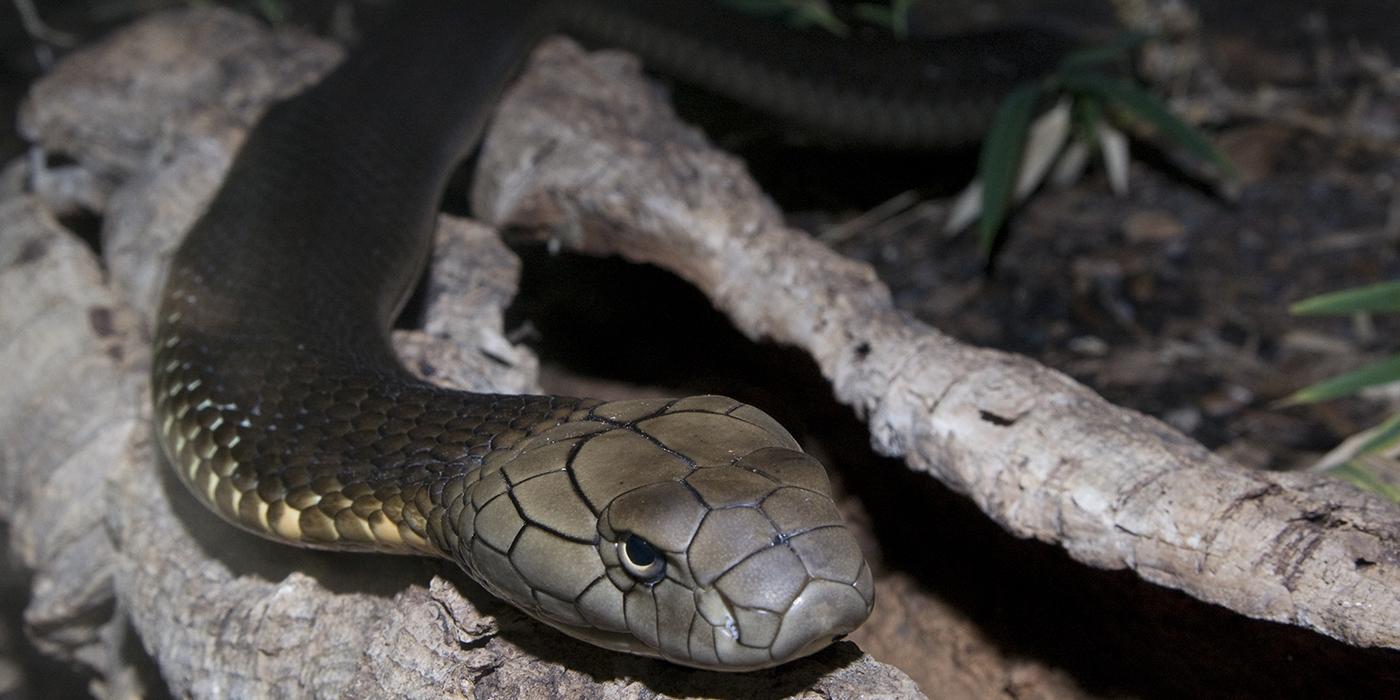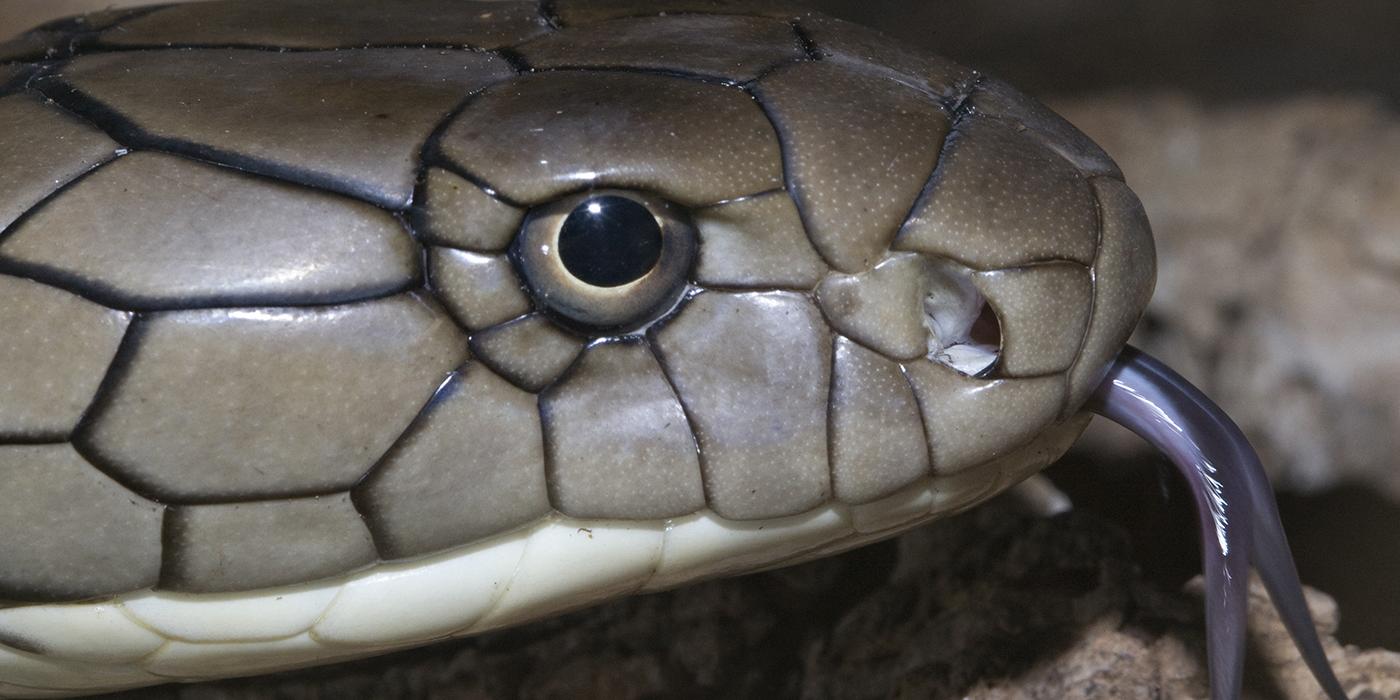Physical Description
A full-grown king cobra is yellow, green, brown or black. They usually also have yellowish or white crossbars or chevrons. The belly may be uniform in color or ornamented with bars. The throat is light yellow or cream-colored. The juveniles are jet-black, with yellow or white crossbars on the body and tail and four similar crossbars on the head. The king cobra is regarded as a fierce and aggressive snake and its length and size give it an awe inspiring appearance.
The king cobra's deadly fangs are almost 0.5 inches (8 to 10 millimeters) long. Because they are fixed to the upper jaw, they have to be short. If they were longer, they would penetrate the floor of its mouth. Angled back into the snake's mouth, the fangs help push the prey on its path to the stomach.
Size
The king cobra's average size is 10 to 12 feet (3 to 3.6 meters), but it can reach 18 feet (5.4 meters).
Native Habitat
King cobras live in Southeast Asia, ranging from northern India, east to southern China, including Hong Kong and Hainan; south throughout the Malay Peninsula and east to western Indonesia and the Philippines.
They prefer streams in dense or open forest, bamboo thickets, adjacent agricultural areas and dense mangrove swamps. They often stay near streams, where the temperature and humidity are relatively constant. They spend almost a fourth of their time up in trees or bushes.
Lifespan
They can live about 20 years in the wild.
Communication
Its eyesight is better than most snakes'. It's good enough to see a moving person almost 330 feet (100 meters) away. The cobra's hiss is much lower than most snakes', more like a dog's growl. It is produced by tiny holes in the trachea and is resonated by the lung. To impress a rival, male king cobras resort to wrestling. Male combat is a ritual conflict in which the first one to push the other's head to the ground wins.
Food/Eating Habits
Although the king cobra is undoubtedly a very dangerous snake, it prefers to escape unless it is provoked. Despite its aggressive reputation, the king cobra is actually much more cautious than many smaller snakes. The cobra only attacks people when it is cornered, in self-defense or to protect its eggs. Throughout its entire range from India to Indonesia, the king cobra causes fewer than five human deaths a year, about one-fifth as many as caused by rattlers in North America. This behavior is not true of nesting females, which may attack without provocation. When in a threat display, these snakes can raise the anterior part of their body about three to four feet (1 to 1.2 meters) off the ground and are able to follow their enemy in this position over considerable distances. The king cobra will also hiss and flatten its neck ribs into a hood. It will assume an upright posture without the hood extended in order to see over bushes or tall grasses.
A bite delivers venom from glands attached to the fangs. The flexing of a small muscle forces the venom through the hollow fangs into the victim. Within minutes, neurotoxins stun the prey's nervous system, especially the impulses for breathing. Other toxins start digesting the paralyzed victim. In the United States, the study of cobra venom has yielded pain relievers such as Cobroxin, used to block nerve transmission and Nyloxin, used for severe arthritis pain.
The king cobra normally restricts its diet to cold-blooded animals, particularly other snakes. Some specimens develop a rigid diet of a single species of snake and will refuse any other type. The snakes eaten by the king cobra are mostly the larger harmless species, such as Asian rat snakes, dhamans and pythons up to about ten feet (3 meters) in length. They may also dine on venomous Indian cobras, kraits and even small king cobras.
At the Smithsonian's National Zoo, king cobras eat mice and rats.
Sleep Habits
These snakes are diurnal.
Reproduction and Development
Breeding usually occurs from January through April. King cobras are oviparous and lay 21 to 40 white, leathery eggs. The female pushes leaves and branches into a nest pile where the eggs are incubated by the elevated temperatures of decomposition. The female remains on top of the nest to guard the eggs, and the male remains close by. During the brood care period, the king cobra tends to be very aggressive toward approaching humans. The eggs of the king cobra incubate during spring and summer, hatching in the fall. It is possible that king cobras mate for life.
Conservation Efforts
King cobras are threatened by the destruction of their habitats and persecution by humans.
Help this Species
Reduce, reuse and recycle — in that order! Cut back on single-use goods, and find creative ways to reuse products at the end of their life cycle. Choose recycling over trash when possible.
Practice ecotourism by being an advocate for the environment when you’re on vacation. During your travels, support, visit or volunteer with organizations that protect wildlife. Shop smart too! Avoid buying products made from animals, which could support poaching and the illegal wildlife trade.
If you see a snake in the wild, leave it alone and encourage others to do the same. Don’t assume it is a venomous species, and don’t attack it if it doesn’t pose a threat to your safety. Tell your friends and family about the eco-services that snakes provide, such as keeping rodent populations in check.
Smithsonian's National Zoo and Conservation Biology Institute. (n.d.). King cobra. Retrieved December 24, 2025, from https://nationalzoo.si.edu/animals/king-cobra




